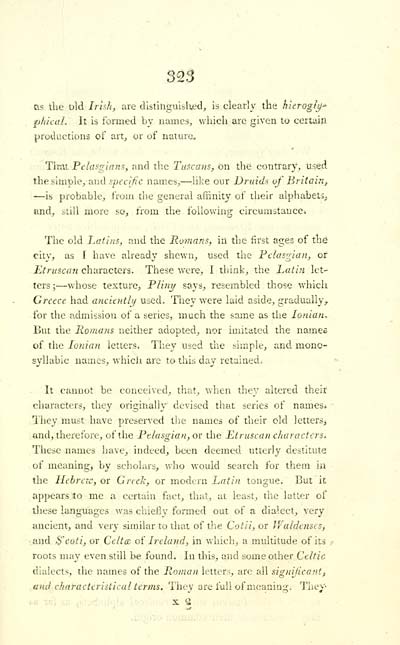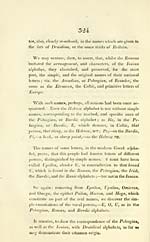Blair Collection > Celtic researches, on the origin, traditions & language, of the ancient Britons
(415)
Download files
Complete book:
Individual page:
Thumbnail gallery: Grid view | List view

323
CIS the üld Irhh, are dlstiliguisked, is clearly tlie hierogly-^
phicaL it is formed by names, which are given to certain
productions of art, or of nature.
Timt Pelasgians, and the Tuscans, on the contrary, used
the simple, and specific names, — like our Druids of Britain,
— is probable, from the general afnnity of their alphabets.
ftnd, still more so, from the following circumstauce.
The old Latins, and the Romans, in the first ages of thö
city, as I have already shewn, used the Fclasgian, or
Etruscan characters. These were, I think, the Latin let-
ters ; — whose texture, Pliny says, resembled those which
Greece had ancie?dly used. They were laid aside, gradually ;,
for the admission of a series, much the same as the Ionian,
But the Romans neither adopted, nor imitated the names
of the Ionian letters. They used the simple, and mono-
syllabic names, which are to this day retained.
It cannot be conceived, that^ when they altered their
characters, they originally devised that series of names*
They must have preserved the names of their old letters,
and, therefore, of the Pelasgian, or the Etruscan characters^
These names have, indeed, been deemed utterly destitute
of meaningj by scholars, who Avould search for them ia
the HebrcTC, or Greek, or modern Latin tongue. But it
appears to me a certain fact, that, at least, tiie latter of
these languages was cliiefiv formed out of a dialect, very
ancient, and very similar to that of the Cotii, or JValdenscs^
and S'coti, or CeltcE. of Ireland, in which, a multitude of its
roots may even still be found. In this, and some other Celtic
dialects, the names of the Roman letter^, arc all significant,
and characteriitical terms. They are full of meaning. They.
CIS the üld Irhh, are dlstiliguisked, is clearly tlie hierogly-^
phicaL it is formed by names, which are given to certain
productions of art, or of nature.
Timt Pelasgians, and the Tuscans, on the contrary, used
the simple, and specific names, — like our Druids of Britain,
— is probable, from the general afnnity of their alphabets.
ftnd, still more so, from the following circumstauce.
The old Latins, and the Romans, in the first ages of thö
city, as I have already shewn, used the Fclasgian, or
Etruscan characters. These were, I think, the Latin let-
ters ; — whose texture, Pliny says, resembled those which
Greece had ancie?dly used. They were laid aside, gradually ;,
for the admission of a series, much the same as the Ionian,
But the Romans neither adopted, nor imitated the names
of the Ionian letters. They used the simple, and mono-
syllabic names, which are to this day retained.
It cannot be conceived, that^ when they altered their
characters, they originally devised that series of names*
They must have preserved the names of their old letters,
and, therefore, of the Pelasgian, or the Etruscan characters^
These names have, indeed, been deemed utterly destitute
of meaningj by scholars, who Avould search for them ia
the HebrcTC, or Greek, or modern Latin tongue. But it
appears to me a certain fact, that, at least, tiie latter of
these languages was cliiefiv formed out of a dialect, very
ancient, and very similar to that of the Cotii, or JValdenscs^
and S'coti, or CeltcE. of Ireland, in which, a multitude of its
roots may even still be found. In this, and some other Celtic
dialects, the names of the Roman letter^, arc all significant,
and characteriitical terms. They are full of meaning. They.
Set display mode to: Large image | Transcription
Images and transcriptions on this page, including medium image downloads, may be used under the Creative Commons Attribution 4.0 International Licence unless otherwise stated. ![]()
| Early Gaelic Book Collections > Blair Collection > Celtic researches, on the origin, traditions & language, of the ancient Britons > (415) |
|---|
| Permanent URL | https://digital.nls.uk/75768460 |
|---|
| Description | A selection of books from a collection of more than 500 titles, mostly on religious and literary topics. Also includes some material dealing with other Celtic languages and societies. Collection created towards the end of the 19th century by Lady Evelyn Stewart Murray. |
|---|
| Description | Selected items from five 'Special and Named Printed Collections'. Includes books in Gaelic and other Celtic languages, works about the Gaels, their languages, literature, culture and history. |
|---|

